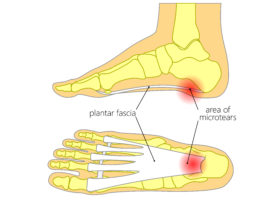Plantar fasciitis, commonly known as heel spurs, is a painful condition caused by minute tears, inflammation, and tissue degeneration of the plantar fascia, the band of connective tissue that stretches across the bottom of the foot from the heel to the toes.
Treatment options for plantar fasciitis, which is the most common cause of heel pain, include anti-inflammatory drugs, physical therapy, night splints, and even Botox injections. Long-term sufferers are often treated with steroid injections or surgery, but there are several safer, more effective treatment options.
One is platelet-rich plasma (PRP). In a recent study, patients with severe chronic plantar fasciitis were treated with either a cortisone (steroid) injection or PRP therapy. Both groups had improvements at the three-month follow up, but the cortisone group’s plantar fasciitis pain returned within six to 12 months, while PRP’s benefits were maintained throughout the two-year study.
PRP treatment involves isolating platelets from a small amount of a patient’s own blood and injecting them into problem areas, where they release bioactive proteins and growth factors that dramatically speed tissue repair and healing. To learn more about PRP for acute or chronic pain, injuries, or degeneration, call the Whitaker Wellness Institute at 866-944-8253.
A Simple Approach to Treating Plantar Fasciitis
If you’d rather avoid injections, I suggest you try a time-honored, noninvasive, inexpensive, and often very successful therapy for the treatment and prevention of plantar fasciitis: support and stabilization of the foot. This can be achieved through the use of over-the-counter orthotics or inserts, devices that are placed in your shoes to take pressure off the fascia and keep the supporting structures in proper alignment.
My patients have had the best luck with products that include arch support pads (either fabric or plastic) on a thin band that wraps around the foot and is held in place with a Velcro strip. One size fits all, so they don’t require any customization. Most brands out there are small enough that they can be worn with most any shoes, even sandals.
A Plantar Fasciitis Success Story
This approach certainly worked for my patient Elizabeth. Elizabeth began running in her mid-30s. As she increased her endurance and distance, she started to experience debilitating pain in her heels and the arches of her feet. She had high arches to begin with, so she purchased arch support inserts to place in her running shoes.
Arch supports helped during her runs, but what really offered lasting relief from plantar fasciitis was wraparound, Velcro-strap, hard arch-support inserts she could wear during the day when flare-ups occurred. Elizabeth has since run five half marathons—pain free.
Recommendations for Plantar Fasciitis
For information on PRP and other pain-relieving therapies we use at Whitaker Wellness to treat plantar fasciitis, call us at 866-944-8253 or visit whitakerwellness.com.
A wide variety of inserts, orthotics, and other devices for plantar fasciitis are available in drug stores, pharmacies, running stores, sporting goods stores, and online.


